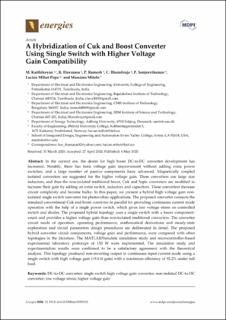| dc.contributor.author | Chokkalingham, Bharatiraja | |
| dc.contributor.author | Padmanaban, Sanjeevikumar | |
| dc.contributor.author | Mihet-Popa, Lucian | |
| dc.contributor.author | Karthikeyan, M | |
| dc.contributor.author | Elavarasi, R | |
| dc.contributor.author | P, Ramesh | |
| dc.contributor.author | Mitolo, Massimo | |
| dc.date.accessioned | 2020-06-04T12:49:46Z | |
| dc.date.available | 2020-06-04T12:49:46Z | |
| dc.date.created | 2020-04-27T12:48:50Z | |
| dc.date.issued | 2020 | |
| dc.identifier.citation | Energies. 2020, 13 (9), 24 s. | en_US |
| dc.identifier.issn | 1996-1073 | |
| dc.identifier.uri | https://hdl.handle.net/11250/2656594 | |
| dc.description.abstract | In the current era, the desire for high boost DC-to-DC converter development has increased. Notably, there has been voltage gain improvement without adding extra power switches, and a large number of passive components have advanced. Magnetically coupled isolated converters are suggested for the higher voltage gain. These converters use large size inductors, and thus the non-isolated traditional boost, Cuk and Sepic converters are modified to increase their gain by adding an extra switch, inductors and capacitors. These converters increase circuit complexity and become bulky. In this paper, we present a hybrid high voltage gain non-isolated single switch converter for photovoltaic applications. The proposed converter connects the standard conventional Cuk and boost converter in parallel for providing continuous current mode operation with the help of a single power switch, which gives less voltage stress on controlled switch and diodes. The proposed hybrid topology uses a single switch with a lower component-count and provides a higher voltage gain than non-isolated traditional converters. The converter circuit mode of operation, operating performance, mathematical derivations and steady-state exploration and circuit parameters design procedures are deliberated in detail. The proposed hybrid converter circuit components, voltage gain and performance, were compared with other topologies in the literature. The MATLAB/Simulink simulation study and microcontroller-based experimental laboratory prototype of 150 W were implemented. The simulation study and experimentation results were confirmed to be a satisfactory agreement with the theoretical analysis. This topology produced non-inverting output in continuous input current mode using a single switch with high voltage gain (≈5.116 gain) with a maximum efficiency of 92.2% under full load. | en_US |
| dc.language.iso | eng | en_US |
| dc.rights | Navngivelse 4.0 Internasjonal | * |
| dc.rights.uri | http://creativecommons.org/licenses/by/4.0/deed.no | * |
| dc.title | A Hybridization of Cuk and Boost Converter Using Single Switch with Higher Voltage Gain Compatibility | en_US |
| dc.type | Peer reviewed | en_US |
| dc.type | Journal article | en_US |
| dc.description.version | publishedVersion | en_US |
| dc.source.pagenumber | 24 | en_US |
| dc.source.volume | 13 | en_US |
| dc.source.journal | Energies | en_US |
| dc.source.issue | 9 | en_US |
| dc.identifier.doi | 10.3390/en13092312 | |
| dc.identifier.cristin | 1808236 | |
| cristin.ispublished | true | |
| cristin.fulltext | original | |
| cristin.qualitycode | 1 | |

